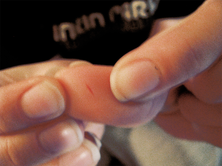|
As a physical therapist, I treat pain. Actually, I treat the cause of one's pain. Pain can be classified as acute or chronic depending on the duration of one's symptoms. Acute pain begins suddenly. It is often described as sharp and usually results from a specific injury. Examples of acute pain include post-surgery, a paper cut, or a sports injury. Chronic pain can be defined as pain lasting greater than 3 months and is often described as dull, nagging, or achy. Chronic pain is vastly different and much more complex than acute pain. In chronic pain, the tissue that was originally damaged has healed. For various reasons, pain signals remain active in the region giving the perception of pain. When thinking about chronic pain, I always picture that one eccentric aunt, who is always talking about her pain at family parties. Her pain never seems to go away, and she is always trying some 'new treatment' to cure it. She defines herself by the pain. What is interesting about pain, is that the severity of the injury does not match the intensity of pain. For example, a paper cut can cause immediate, intense pain, versus a broken bone may go unnoticed. In 2013, when Louisville basketball player Kevin Ware sustained a horrific leg fracture, he reported, "it was one of those things where I couldn't believe it. I honestly didn't feel the pain. It was more a shock." The perception of pain and the context of the injury matters significantly. A variety of treatments exist for both acute and chronic pain. Acute pain is best managed with rest, ice, compression, elevation, and protecting the site of injury. Chronic pain is more difficult to treat. It requires a special treatment plan focused on education, aerobic activity, and reprogramming the nervous system (see the video below). Take home message: Both acute and chronic pain is real, but one's perception of the pain will alter the response to it. Physical therapy has been shown to be effective in resolving both types of pain. The video drawing above is a simple and accurate representation of how and why pain occurs. I have given this to many patients to help them understand why they are having pain. To learn more about your pain, contact Heafner Health to learn more information or schedule an appointment.
P: 618-604-3293 E: [email protected] -Jim Heafner PT, DPT, OCS
2 Comments
Manuel Franco
8/29/2023 10:52:37 pm
I just want to say Thank You to everyone who supported me through the years. My name is Manuel Franco, New Berlin, Wisconsin. My story of how I won the Powerball lottery of $768.4M is a bit of a tale. I have been playing Powerball tickets for 6 years now since I turned 18. I bought my first ticket on my 18 birthday. I was feeling very lucky that day because I had contacted Dr. Odunga Michael to help me with the winning Powerball numbers. I really had that great great feeling that I looked at the camera wanting to wink at it. I only did a tiny part of it and trusted him. He gave me the numbers after I played a couple other tickets along with it for $10. I checked my ticket after the winnings came online and saw the numbers were correct including the Power play. I screamed for about 10 minutes because it felt like a dream. I had won $768.4M. You can check my winning testimony with the lottery officials just with my name search. Thank you Dr Odunga. Well, his email is [email protected] and you can also call or Whats-app him at +2348167159012 so you guys can contact him
Reply
Hailey Garcia
6/20/2024 11:12:57 pm
My name is Hailey Garcia and I am from New Jersey. My herpes virus turned to war after 2 years of living with it. I have tried different medical procedures to cure my herpes but to no avail. Most people think herpes is only a minor skin irritation of which herpes has long term effects on health and passes through the bloodstream and can be easily contracted through sexual intercourse. I knew I had herpes from the first day I started feeling itchy in my pubic area and the pain was very unbearable. I couldn't stand it anymore. After 2 years of trying other means to get rid of it, I had to contact Doctor Odunga to help me with a permanent cure. I saw his email and whats-app number from a testimony I read online from a lady who was also helped by him in curing infertility problems, I had faith and contacted him. He assured me of his work and I ordered his herbal medicine. Within 5 days, I didn't feel any pain anymore and within 2 weeks, my skin was all cleared and smooth. I am very grateful to you sir and I write this testimony as others have done to bring those having faith to you sir. If you have herpes or other similar disease and you want it cured, kindly contact Doctor Odunga, Whats-App (wa.me/+2348167159012) OR Email [email protected]
Reply
Leave a Reply. |
Heafner HealthPhysical Therapy Archives
April 2024
Categories |




 RSS Feed
RSS Feed
